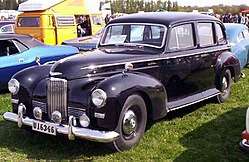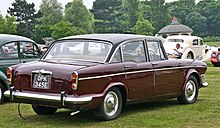Humber Pullman
|
Humber Pullman / Imperial New Imperial |
|
|---|---|
| Production period: | 1930–1940 1945–1954 1964–1967 |
| Class : | Upper class / upper middle class |
| Body versions : | Limousine , Pullman limousine , landaulet , coupe , convertible |
| Previous model: | Humber 20/65 hp |
The Humber Pullman is a car of the luxury class , the Humber produced from the 1930th In 1939 the Rootes Group , which had taken over Humber in 1931, put the Humber Imperial at his side.
Pullman (1930-1935)
| Pullman 1930 | |
|---|---|
|
Image does not exist |
|
| Production period: | 1930-1935 |
| Body versions : | Pullman sedan , landaulet , coupé |
| Engines: |
Otto engine : 3.5 liters (59 kW) |
| Length: | |
| Width: | |
| Height: | |
| Wheelbase : | 3353 mm |
| Empty weight : | |
The first Humber Pullman was introduced in 1930 as the successor to the 20/65 hp model and version of the Snipe 80 with an extended wheelbase. Like the Snipe 80, the car had a six-cylinder in-line engine with 3498 cm³ displacement and counter-controlled valves (ioe) and an output of 80 bhp (59 kW). The classic Pullman sedan with four rear-hinged doors also corresponded roughly to the Snipe 80, but was a little longer and wider. The heavy car reached a top speed of 117 km / h.
A coupe was only offered in 1935.
Pullman (1936–1940) and Imperial (1939–1940)
| Pullman 1936 / Imperial 1939 | |
|---|---|
|
Image does not exist |
|
| Production period: | 1936-1940 |
| Body versions : | Limousine , Pullman limousine , landaulet , cabriolet |
| Engines: |
Otto engine : 4.1 liters (74 kW) |
| Length: | 4876-4978 mm |
| Width: | |
| Height: | |
| Wheelbase : | 3251-3353 mm |
| Empty weight : | |
A slightly revised body appeared in 1936. The wheelbase was retained, but the superstructure was extended to 4978 mm. The cars now had a two-part, arrow-shaped windshield. Like the contemporary Super Snipe , the Pullman was powered by a drilled out six-cylinder in-line engine with 4086 cm³ displacement, which delivered an output of 100 bhp (74 kW). The coupé was no longer available, the Pullman was offered as a Pullman sedan and landaulet. The top speed increased to 121 km / h.
In 1939 the Pullman was joined by the Humber Imperial . It had a chassis that was 102 mm shorter and was available as a sedan or convertible. With the same engine and the slightly smaller body, the model reached 130 km / h. The car was particularly popular with British government ministers. One year after the appearance of the Imperial, production of both models was stopped due to the war.
Pullman Mark I.
| Pullman Mark I. | |
|---|---|
|
Hillman Pullman Mark I. |
|
| Production period: | 1945-1948 |
| Body versions : | Pullman limousine , landaulet |
| Engines: |
Otto engine : 4.1 liters (74 kW) |
| Length: | 4978 mm |
| Width: | |
| Height: | |
| Wheelbase : | 3353 mm |
| Empty weight : | |
In 1945 the new Pullman Mark I with a revised body appeared first . The doors were now hinged at the front, the body had a rounder design with an attached trunk. The well-known 4.1 liter engine served as the drive.
Pullman Mark II / III and Imperial Mark II
| Pullman Mark II / III / Imperial Mark II | |
|---|---|
|
Humber Pullman Mark II |
|
| Production period: | 1948-1953 |
| Body versions : | Limousine , Pullman limousine , landaulet |
| Engines: |
Otto engine : 4.1 liters (74 kW) |
| Length: | -5385 mm |
| Width: | |
| Height: | |
| Wheelbase : | |
| Empty weight : | |
In 1948 the new Pullman Mark II appeared with a further revised body. The headlights had moved into the front fenders and the windshield was again one-piece. Chassis and superstructures were lengthened compared to the previous model. The Pullman sedans and landaulets were offered as Pullman; the sedan introduced at the same time was available as the Imperial Mark II with the same technical data.
1951 came the Pullman Mark III , which was just as long as the Rolls-Royce Silver Cloud at 5385 mm . The Imperial was built unchanged. The drive also remained the same.
By 1953, 2200 copies of the Pullman Mark II / III had been made and 1526 copies of the Imperial Mark II.

Pullman Mark IV and Imperial Mark IV
| Pullman Mark IV / Imperial Mark IV | |
|---|---|
|
Image does not exist |
|
| Production period: | 1953-1954 |
| Body versions : | Limousine , Pullman limousine , landaulet |
| Engines: |
Petrol engines : 4.1 liters (83-85 kW) |
| Length: | 5385 mm |
| Width: | |
| Height: | |
| Wheelbase : | |
| Empty weight : | |
In 1953, both models received the Pullman Mark IV and Imperial Mark IV , respectively , a new engine with 4139 cc displacement, overhead valves (ohv) and an output of 113 bhp (83 kW) or 116 bhp (85 kW). The new engine had overhead valves . A year later, both models were discontinued.
New Imperial
| New Imperial | |
|---|---|
|
Humber New Imperial (1966) |
|
| Production period: | 1964-1967 |
| Body versions : | Pullman limousine |
| Engines: |
Otto engine : 3.0 liters (94.5 kW) |
| Length: | 4775 mm |
| Width: | 1765 mm |
| Height: | 1575 mm |
| Wheelbase : | 2794 mm |
| Empty weight : | |
Ten years later, in 1964, a Humber New Imperial , a Pullman sedan with a self-supporting body, panoramic windows and tail fins, appeared . Basically it was a Super Snipe Series V , which was better equipped, a vinyl roof and had a Borg-Warner 35 automatic transmission as standard . The British coachbuilder Thrupp & Maberly , whose last vehicle produced was the Humber New Imperial, produced between 38 and 41 left-hand drive models. The new 6-cylinder OHV in-line engine had a displacement of 2965 cm³ and developed an output of 128.5 bhp (94.5 kW). The maximum speed of the car is given as 161 km / h. In 1967 the model was discontinued without a successor.
literature
- David Culshaw, Peter Horrobin: The Complete Catalog of British Cars 1895-1975. Veloce Publishing plc, Dorchester 1997, ISBN 1-874105-93-6 .
Individual evidence
- ↑ a b c M. Sedgwick, M. Gillies: A – Z of Cars of the 1930s . Bay View Books, Devon 1969, ISBN 1-870979-38-9 .
- ↑ a b c d e f g h i j David Culshaw, Peter Horrobin: Complete Catalog of British Cars . Macmillan, London 1974, ISBN 0-333-16689-2 .
- ^ G. Robson: A – Z British Cars 1945–1980 . Herridge & Sons, Devon 2006, ISBN 0-9541063-9-3 .
- ↑ a b The Humber Super Snipe. In: The Motor. February 10, 1960.
- ↑ BLACKPOT FEVER: 1966 Humber Imperial left-hand drive. July 13, 2017, accessed on August 3, 2017 (reference from 3:49).



